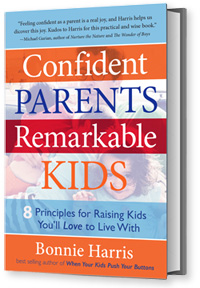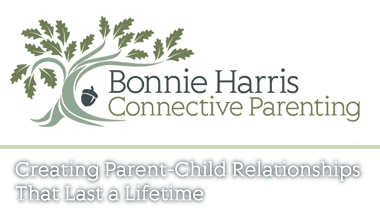Even after I outline problem solving to a frustrated parent of a child who just keeps pushing the limits, I get the same reply. “Yeah, okay, but what do I DO?”
It’s hard to understand at first that logical words, emotional understanding and empathy, and asking the child to think is actually DOING anything. We are so accustomed to grounding, time outs, taking away privileges, threatening, and withholding. It’s hard to think a respectful process of working it out is doing something.
What’s hard is dropping the notion that we have to make our children miserable in order to teach lessons.
Break it down. If you do any of the above, you are necessarily causing hurt (understanding behavior). The misguided thinking is that if our children are miserable enough, they will decide not to do the deed again and voila—learning takes place.
Well, yes, learning takes place, but not the kind you are counting on. What they feel is anger, frustration, resentment, misunderstood, unheard. What they learn is:
- You are not the one to share feelings with or get advice from
- How to get sneaky so you don’t know what they’re doing
- Revenge and retaliation

Who learns to be better when they are miserable? I’m not suggesting that after your child has thrown a book at his sister you want him to feel good. But blaming him will send him into defensive reactions—fighting back, blaming sister, or laughing and pretending not to care.
Blame
 When we blame our children, they naturally start building a wall of defense to protect themselves from what they perceive as an attack. In defense mode—lying, retaliating, laughing, running—they miss the opportunity to take in the natural consequence of their behavior—what their behavior has wrought—because all they can think about is getting in trouble.
When we blame our children, they naturally start building a wall of defense to protect themselves from what they perceive as an attack. In defense mode—lying, retaliating, laughing, running—they miss the opportunity to take in the natural consequence of their behavior—what their behavior has wrought—because all they can think about is getting in trouble.
Blame never serves a purpose. It is the retaliation of an exasperated parent. It’s using power to intimidate and force a child to do it our way. Isn’t that what bullies do?
Connection
The first and most important stage of problem solving is connection—empathizing with your child no matter what has happened. Empathy is understanding why your child, due to his temperament, stage of development, circumstances, etc. thinks or feels the way he does. Empathy says to your child, “I get it.” It does not say, “I agree with you.”
Typical scenario:
When Joseph hits his brother Ian, causing screams and tears, Mom yells, “How many times have I told you there is no hitting in this house? What is wrong with you?” and takes screen privileges away. Joseph learns:
- Mom likes Ian better
- I am bad
- I’ll get back at Ian for getting me in trouble
- Nobody ever sees what Ian does. I’m the only one who EVER gets in trouble
- I have to grab computer time cause Mom takes it away all the time
- How to get what I want from somebody weaker than me
Frustration and anger builds the more Joseph gets in trouble. Joseph’s behavior gets worse. The cycle continues.

Notice how many times “get in trouble” comes up. When you use problem solving instead of punishment and threats, “getting in trouble” is not feared and is never a motive for defense, protection, sneakiness, or blaming others—because it’s not in the family lexicon.
New scenario:
Mom comforts Ian without mentioning Joseph. After all emotions have cooled (it’s pointless to use reason when emotions are flooding everyone) and the thinking brain is back online, Mom gets a quiet moment with Joseph and says, “I know you know it’s not okay to hit your brother, so when you did, it told me that you must have been so annoyed or angry with him that you couldn’t control yourself.” Pause. NO BUTS.
Joseph will likely agree and possibly explain what happened. Then Mom has more information. “I get it. You thought Ian was about to wreck your lego ship. I certainly understand why that would make you crazy. You worked so hard on that ship.”
Now Joseph feels understood—connection.

Then problem solving: “Can you think of another way you could have handled the anger you felt without hitting him?” At this point, Joseph is calm, he feels understood, and his thinking brain can work. He might come up with ideas you don’t like and you can say, “I get why you might want to do that. I’m not okay with that one. More ideas?” Keep facilitating Joseph’s thinking process until he says something you can agree with. “That sounds like a great idea. Think you can try that next time?”
There’s no guarantee that Joseph will do this. Impulses take over in young children. But he has created the mental pathway and will get there sooner rather than later.
Problem Solving teaches critical thinking
 After connection has been made and the child feels understood, then thinking is called on. The parent or teacher facilitates the child’s thought process by asking questions, not by telling the child what to do. When the child thinks through the possibilities, it becomes a process he can do. It never works to expect him to do what you would do.
After connection has been made and the child feels understood, then thinking is called on. The parent or teacher facilitates the child’s thought process by asking questions, not by telling the child what to do. When the child thinks through the possibilities, it becomes a process he can do. It never works to expect him to do what you would do.
The #1 rule of problem solving: Everyone involved must agree on the solution. Don’t stop until agreement is reached. Therefore no ones loses, compromise is learned, everyone’s perspective is respected. Children engage in the process when they know they are not getting in trouble. No blame, no punishment, no misery. Cooperation is far more likely. Your role is facilitator and guide. You do NOT need to know the answer.
5 Steps to problem solving:
- Empathize, connect. Share power rather than impose it.
- Clarify your concern; own it. “I don’t like it when….”
- Guide child’s thought process with questions.
- Brainstorm solutions starting with child. How can we make this work for both of us. Can offer suggestions, choices, but don’t solve the problem or dictate what to do.
- Come to a mutually satisfactory solution to the problem.
Other uses of problem solving:
- “Calling me names is not okay with me. Let me know when you can ask for what you want in a respectful way.”
- “You want to watch your video and I want help with the dishes. How do we make it work so we both get what we want?”
- “I’m worried about what will go on at the party. I know you aren’t. How can we work it out so I feel okay and you get what you want?”
- “If you refuse to help then I am not going to feel so cooperative next time you want my help. How can we work this out so that doesn’t happen?”
It’s easy to punish—because it’s what was done to us.
It’s hard to problem solve—because no one ever did it with us. But there is no greater skill to teach your children.

Confident Parents, Remarkable Kids: 8 Principles for Raising Kids You’ll Love to Live With can help you shift your perspective of your child and his behavior so that your anger can shift to compassion and understanding — frustration probably; annoyance undoubtedly, but much less anger.







